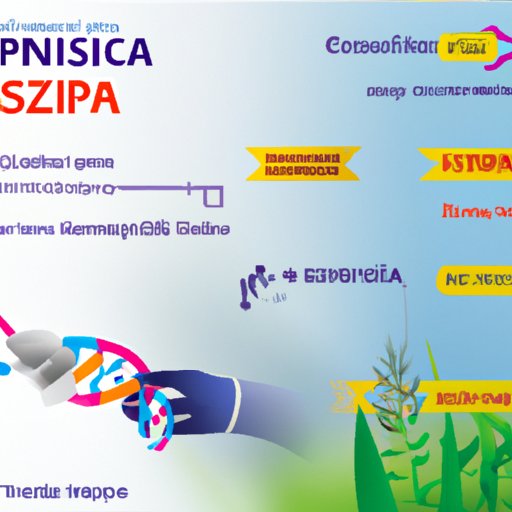Introduction
CRISPR (Clustered Regularly Interspaced Short Palindromic Repeats) is a revolutionary gene-editing technology that has the potential to revolutionize medicine, agriculture, and many other industries. It works by using a combination of enzymes and DNA strands to target and modify specific genes in an organism. In this article, we’ll explore how CRISPR works and investigate the potential benefits and risks associated with its use.
Exploring the Science Behind How CRISPR Works
At its core, CRISPR is a tool for gene editing. This technology makes it possible to precisely target and modify specific genes within an organism. The CRISPR-Cas9 system is the most commonly used form of CRISPR technology, and it works by using a combination of enzymes and DNA strands to target and modify a specific gene. The Cas9 enzyme acts as a pair of molecular scissors, cutting the targeted gene at a specific location. Once the gene is cut, the cell can then replace the gene with a new sequence of DNA. This process is known as gene editing.
On a molecular level, CRISPR works by first identifying the targeted gene sequence. The CRISPR-Cas9 system contains a short strand of RNA that is designed to recognize and bind to the targeted gene. The Cas9 enzyme then binds to the RNA strand and cuts the targeted gene, allowing the cell to replace it with a new sequence of DNA. This process makes it possible to edit specific genes within an organism and alter its genetic makeup.
CRISPR technology has many potential applications, from medical treatments to research to agricultural and industrial uses. Scientists are currently exploring ways to use CRISPR to treat diseases such as cancer, HIV, and Huntington’s disease. Additionally, CRISPR could be used to develop new crops and improve agricultural yields, or to create more efficient industrial processes.

Investigating the Benefits and Risks of CRISPR
CRISPR technology has many potential benefits. One of the most promising applications is its ability to treat genetic diseases. By using CRISPR to edit out mutated genes, scientists may be able to cure diseases such as cystic fibrosis, sickle cell anemia, and muscular dystrophy. Additionally, CRISPR could be used to improve crop yields and create new food sources, or to develop more efficient industrial processes.
However, there are also some potential risks associated with CRISPR technology. One of the greatest concerns is the potential for unintended consequences. If CRISPR is used to edit a gene, there is a chance that it could cause unintended mutations or other unwanted effects. Additionally, there are ethical considerations when it comes to using CRISPR to modify human embryos, which could lead to unintended changes in future generations. Finally, there are also concerns about the safety of using CRISPR in humans, as it is still a relatively new technology.

Examining the Potential Uses of CRISPR
CRISPR technology has many potential applications, both in medicine and in other areas. In medicine, CRISPR could be used to treat genetic diseases, as well as to develop new treatments for cancer, HIV, and other illnesses. Additionally, CRISPR could be used to improve crop yields and create new food sources, or to develop more efficient industrial processes. In the future, CRISPR could even be used to create new organisms or materials, or to clean up polluted environments.
Analyzing the Pros and Cons of CRISPR
CRISPR technology has many potential benefits, including the ability to treat genetic diseases, improve crop yields, and create new organisms. However, there are also some potential risks associated with CRISPR, such as unintended consequences and ethical considerations. Additionally, there are safety concerns related to using CRISPR in humans, as it is still a relatively new technology.

A Comprehensive Guide to Understanding CRISPR
CRISPR technology is a revolutionary gene-editing tool that has the potential to revolutionize medicine, agriculture, and many other industries. Here is a comprehensive guide to understanding CRISPR:
- What is CRISPR? CRISPR is a gene-editing technology that makes it possible to precisely target and modify specific genes within an organism.
- How does CRISPR work? CRISPR works by using a combination of enzymes and DNA strands to target and modify a specific gene. The Cas9 enzyme acts as a pair of molecular scissors, cutting the targeted gene at a specific location.
- What are the benefits and risks of using CRISPR? CRISPR technology has many potential benefits, such as the ability to treat genetic diseases and improve crop yields. However, there are also some potential risks, including unintended consequences and ethical considerations.
- What potential uses does CRISPR have? CRISPR could be used to treat diseases such as cancer, HIV, and Huntington’s disease, as well as to develop new crops and improve agricultural yields, or to create more efficient industrial processes.
- What are the pros and cons of CRISPR? The benefits of CRISPR include its potential to treat genetic diseases, improve crop yields, and create new organisms, while the challenges posed by CRISPR include potential unintended consequences, ethical considerations, and safety concerns.
Conclusion
CRISPR technology is a revolutionary gene-editing tool with the potential to revolutionize medicine, agriculture, and many other industries. In this article, we explored how CRISPR works, investigated the potential benefits and risks associated with its use, and examined its various potential uses in medicine, agriculture, industry, and the environment. We also analyzed the pros and cons of CRISPR and provided a comprehensive guide to understanding this powerful technology.
(Note: Is this article not meeting your expectations? Do you have knowledge or insights to share? Unlock new opportunities and expand your reach by joining our authors team. Click Registration to join us and share your expertise with our readers.)
